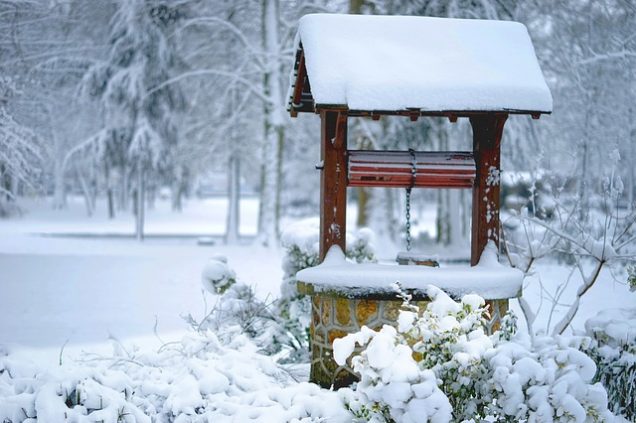‘Tis the season to be worried about frozen, or worse, burst pipes. Here at Greco & Haines, we get many questions about the risk of “frozen wells” and general methods for winterizing one’s domestic well water supply. This article will explain everything you need to know about keeping your well water system from freezing in the winter. Let’s take a closer look:
Do Wells Freeze?
Your well itself is not in danger of freezing, as it’s situated below the frost line. Here in Connecticut, the frost line’s roughly 42 inches deep, so it’s the soil above that depth that’s susceptible to freezing. For that reason, you don’t have to worry about how to prevent your well from freezing as it’s those well-system components situated at shallower levels or aboveground that are more at risk.
Can a Well Pump Freeze?
In the same way, an underground well pump freeze is unlikely. Submersible well pumps that actually operate down inside the well, essentially pushing water upwards, are not vulnerable to a freeze-up. By contrast, jet pumps, which tend to be situated within homes or basements and function by pulling water up from the well and into home plumbing, could indeed be at risk of freezing.
Other components of your well system vulnerable to subzero temperatures are the supply pipes conveying water from the well to the pump and your household distribution system. The water inside a well pump and any pipes exposed to temperatures around or below 32 degrees Fahrenheit are at risk of freezing up. This can cause substantial damage to your system, plunge water pressure, and result in costly leaks and repairs.
While the most vulnerable pieces of your well system are those above the frost line and situated within unheated parts of your house, you also want to keep in mind those unpredictable events where you lose household heat. This may place plumbing and fixtures normally well protected from cold temperatures at risk of freezing.
Remember that if your supply pipes are situated in an unheated area such as a crawlspace, strong winds can lower the effective temperature and cause water to freeze even if the actual temperature is above freezing.
Protecting Your Well Pump and Pipes From Freezing Temperatures
If you’ve ever asked yourself, “How do I winterize my well water system?” the good news is the process is pretty straightforward. Again, the initial installation of your well and primary supply pipes will have been placed below the frost line, taking them off the table in terms of things to worry about when freezing temperatures roll in.
Aboveground or shallow-level components of your well system should be insulated from frigid temperatures — that’s true for any Connecticut property. Your wellhead and jet pump should be situated within insulated housing, and water lines should be bundled up with foam insulation sleeves or tubes.
However, in a pinch, everything from bubble wrap to old clothing can be employed for the purpose. Heat tape can also be used to insulate pipes; just remember to space it out by an inch or so. You may further protect wellheads or jet pumps with heat lamps or incandescent light bulbs.
Running Your Taps
If you’ve lost power or concerned that freezing temperatures may threaten even well-insulated water pipes, you can significantly decrease the chance of a freeze-up and, potentially, burst plumbing by running your taps during cold fronts. Just a trickle or rapid drip from your faucet is typically enough to prevent ice formation and relieve pressure, and the amount of water you’re “wasting” in the process is truly negligible — especially when compared with the cost of having to repair a broken pipe or destroyed jet pump.
If Your Pipes Have Frozen
Despite your best efforts, you may run into a situation during an unexpectedly severe cold snap or a prolonged loss of power for heating where there’s an ice jam somewhere in your well water system. The indication may be diminished water pressure or maybe nothing coming out of your taps at all.
Open your taps (to relieve pressure) and attempt to locate where the freeze has occurred. You can try to unthaw pipes using heat tape or even a hairdryer. Remove this heat source once the water starts flowing from the taps.
If you can’t seem to unthaw your system, it’s high time to get in touch with a professional. And even if you manage to get the water flowing again, it’s a good idea to have your system inspected to ensure there’s no leak stemming from the freeze-up.
Winterize Your Well System With Help From Greco & Haines
At Greco & Haines, our experts know it’s always a good idea to have your thorough annual well inspection done ahead of winter’s harsh conditions to make sure everything’s in good shape and that there aren’t any problems to address. Basic maintenance and repairs are generally easy to take care of before the ground freezes and inclement winter weather sets in.
Greco & Haine’s is here for you seven days a week, 365 days a year — especially on those harsh winter days here in Connecticut. If you have questions about winterizing your well system or have a freeze-up issue, don’t hesitate to get in touch with our team of experts.
Contact us today to learn more!

